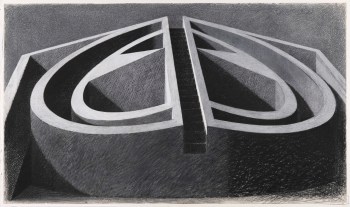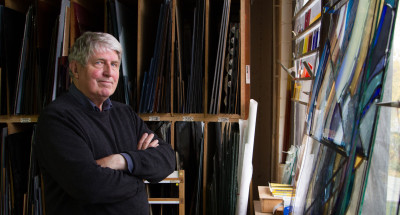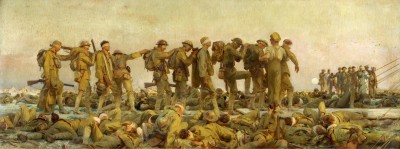John Maine RA (b. 1942)
John Maine studied at the West of England College of Art from 1960 to 1964 before moving to London to attend the Royal College of Art for a further three years until 1967. After graduating, he became the first fellow at Gloucestershire College of Art, a two-year appointment. He then set up a sculpture studio in Shoreditch, London, and travelled widely. Influences from these journeys (especially to Mexico) strongly affected his work. He was awarded the first fellowship at the Yorkshire Sculpture Park, where he developed these ideas over two years from 1979 to 1980.
He subsequently worked in Carrara and attended the Hagi Symposium in Japan, which stimulated a lasting interest in Japanese culture. Commissioned by the Government Art Collection, he spent a year in Australia carving a granite work for the British High Commission, Canberra. Returning to London, he worked in situ to carve Arena on the South Bank outside the National Theatre. This practice of creating large works in landscape was developed further in Portland, Dorset, where he made the Chiswell Earthworks, as part of the Common Ground New Milestones Project.
Recently he has been working for extended periods in Scotland. His Entrance Works at Standard Life House, and the 8 metre high granite sculpture at the Royal Bank of Scotland, both in Edinburgh, are closely integrated with aspects of architecture. He is currently working on projects in Aberdeenshire including Place of Origin, a major sculpture/landscape project at the Kemnay granite quarries.
During the 1970s and 1980s John Maine was a part time lecturer in many art colleges, including the Royal College of Art, London. Subsequently, he has become an external assessor for various BA Hons and MA courses, and lectures occasionally.
His first solo exhibition was held at the Serpentine Gallery (1972). Since then he has shown regularly in Britain, with occasional exhibitions abroad. Among his group exhibitions are The Condition of Sculpture, Hayward Gallery, London (1975), A Silver Jubilee Exhibition of Contemporary British Sculpture, Battersea Park, London (1977), Sculptors’ Drawings, The British Council Tour of the Far East (1984), From Art to Archaeology, South Bank Centre and tour (1991), Sculpture at Goodwood (1995) and Sculpture, an Abbey and a Cathedral, Gloucester Cathedral (2000).
Maine was elected Royal Academician in 1995 and a Member of the Royal West of England Academy in 1997. He has been a Commissioner at the Cathedrals Fabric Commission for England since 1996. He is a member of the Westminster Abbey Fabric Commission and the Fabric Advisory Committee of St. George’s Windsor. John Maine lives and works in Wiltshire.
Profile
Born: 1942 in Bristol, Avon, England, United Kingdom
Nationality: British
Elected RA: 22 May 1995
Elected Senior RA: 1 October 2018
Gender: Male
Preferred media: Sculpture
Works by John Maine in the RA Collection
2 results
Works associated with John Maine in the RA Collection
1 results
-
Gallery

John Maine RA, Bedrock.
-
John Maine RA - Selected CV
-
Recent Solo Exhibitions
2012 Art on the Underground, Green Park, London
2011 Royal Academy of Arts, London
2003 Howden Minster, Yorkshire
2001 Dissenters’ Chapel Gallery, London
1994 Konishi Gallery, Kyoto, Japan
1992 Winchester Cathedral
1980 Warwick Arts Trust, London
1978 Yorkshire Sculpture Park
1972 Serpentine Gallery -
Selected Collections
Aberdeenshire Council
Arts Council of Great Britain
Bharat Bhavan Bhopal, India
Birmingham City Art Gallery
British Council
British High Commission, Canberra, Australia
British Museum
Cleveland Gallery, Middlesborough
Contemporary Arts Society
Hagi City, Japan
Kilkenny County Council, Ireland
Kingston Polytechnic Library
London Borough of Camden
London Borough of Lewisham
Middlesborough Art Gallery
National Gallery of Victoria, Australia
Portland Town Council
Portsmouth City Museum
Ryugasaki Town Council, Iberaki Prefecture, Japan
Wakefield City Art Gallery -
Selected Prizes
Royal College of Art Drawing Prize
The Bence Pritchard Bequest
The Walther Neurath Prize
Cleveland Biennial Drawing Prize
The Mark Rothko Memorial Trust Award The
Henry Moore Foundation award
The Elephant Trust award
Japan Foundation award
-
-
Art Sales at the RA
-

Studies for Cylinders
Possibilities of vertical composition are excitedly explored in this working sheet of drawings – the kind of small-scale aid John Maine RA regularly uses to visualise his new sculptures.
Details reveal possible surface treatments of stacked cylinders based on interwoven geometrics. Such early sketches form a key part of Maine’s creative process. They help the contemporary sculptor explore new directions for his work, and enable him to express ideas more dynamically than in more controlled drawings.
-

Stack 2
Light and shade reinforce and camouflage the form in this dramatic etching. It relates to the first drawings John Maine RA prepared for a sequence of stacked sandstone cylinders he sculpted in 1995.
Deeply incised columns at Howden Minister, where a granite version of this work is permanently installed, inspired Maine. Likewise, the animated form and surface reliefs of the Romanesque columns at York Minster’s crypt.
-

Quayside
How to integrate the outfall of a hidden river into Newcastle’s cityscape is the subject of this experimental and visceral work. John Maine RA produced it by brushing the image directly onto the etching plate.
Still in proposal form, the final three-dimensional work is yet to be realised, although Maine has already completed a paving scheme on a pedestrian street, close to the proposed location on the bank of the Tyne.
-








